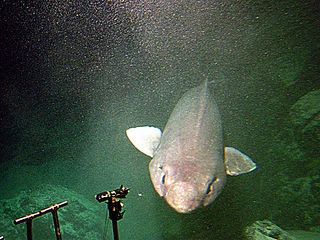The sixgill sharks are a genus, Hexanchus, of deepwater sharks in the family Hexanchidae. These sharks are characterized by a broad, pointed head, six pairs of gill slits, comb-like, yellow lower teeth, and a long tail. The largest species can grow up to 8 m long and weigh over 600 kg (1320 lb). They are continental shelf-dwelling and abyssal plain scavengers with a keen sense of smell and are among the first to arrive at carrion, together with hagfish and rattails. They show a characteristic rolling motion of the head when feeding.

The false catshark or sofa shark is a species of ground shark in the family Pseudotriakidae, and the sole member of its genus. It has a worldwide distribution, and has most commonly been recorded close to the bottom over continental and insular slopes, at depths of 500–1,400 m (1,600–4,600 ft). Reaching 3.0 m (9.8 ft) in length, this heavy-bodied shark can be readily identified by its elongated, keel-like first dorsal fin. It has long, narrow eyes and a large mouth filled with numerous tiny teeth. It is usually dark brown in color, though a few are light gray.

Hover flies of the genus Microdon are unusual among the Diptera. Like other members of the subfamily, they are myrmecophiles, meaning they inhabit the nests of ants.
The small Luzon forest mouse is a species of rodent in the family Muridae. It is found only in the Philippines.
The Cumberland dusky salamander is a species of salamander in the family of lungless salamanders, Plethodontidae. It is endemic to the United States. Its natural habitats are temperate forests and rivers. This species is threatened by habitat loss.

Eriphostoma is an extinct genus of gorgonopsian therapsids known from the Middle Permian of Tapinocephalus Assemblage Zone, South Africa. It has one known species, Eriphostoma microdon, and was first named by Robert Broom in 1911. It is the oldest known gorgonopsian and among the smallest and most basal members of the clade.

Cantius is a genus of adapiform primates from the early Eocene of North America and Europe. It is extremely well represented in the fossil record in North America and has been hypothesized to be the direct ancestor of Notharctus in North America. The evolution of Cantius is characterized by a significant increase in body mass that nearly tripled in size. The earliest species were considered small-sized and weighed in around 1 kg, while the later occurring species were considered medium-sized and likely weighed in around 3 kg. Though significantly smaller, the fossil remains discovered of the various species of Cantius have striking similarities to that of Nothartcus and Smilodectes. It is likely Cantius relied on arboreal quadrupedal locomotion, primarily running and leaping. This locomotor pattern comparable to that of extant lemurs, which has fostered the hypothesis that Cantius and other strepsirrhine adapiforms may have a close phylogenetic affinity to living lemurs.
Gilloblennius abditus, known commonly as the obscure triplefin, is a species of triplefin blenny in the genus Gilloblennius. It was described by Graham Stuart Hardy in 1896. It is endemic to New Zealand where it has a disjunct distribution around North and South Islands where there are highly exposed rocky coasts.

Ikrandraco is a genus of lonchodraconid pterodactyloid pterosaur known from Lower Cretaceous rocks in northeastern China and the Cambridge Greensand of the UK. It is notable for its unusual skull, which features a crest on the lower jaw.
Microdon manitobensis is a species of syrphid fly in the family Syrphidae.
Microdon globosus is a species of syrphid fly in the family Syrphidae.
Hexacylloepus is a genus of riffle beetles in the family Elmidae. There are about 19 described species in Hexacylloepus.
Microdon tristis is a species of syrphid fly in the family Syrphidae.
Microdon craigheadii is a species of syrphid fly in the family Syrphidae.
Ataenius abditus is a species of aphodiine dung beetle in the family Scarabaeidae. It is found in North America.
Microdon megalogaster is a species of syrphid fly in the family Syrphidae.
Microdon aurulentus is a species of syrphid fly in the family Syrphidae.
Microdon lanceolatus is a species of syrphid fly in the family Syrphidae.

Delphastus is a genus of lady beetles in the family Coccinellidae. There are more than 20 described species in Delphastus.
Microdon fulgens is a species of syrphid fly in the family Syrphidae.





